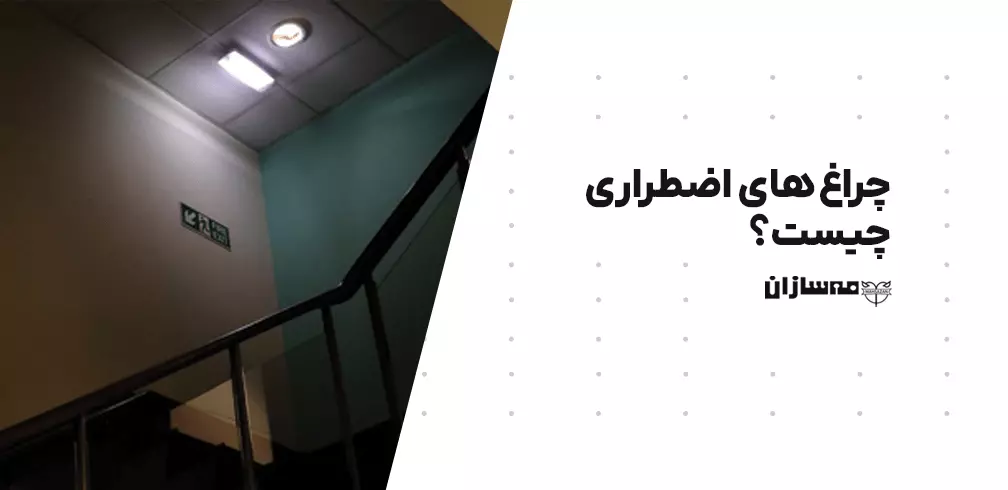The emergency light is used when the input power is cut off and total blackout occurs. At this time, these systems are turned on and provide ambient lighting. Each of these systems has a storage battery that can usually stay on for 3 hours or more.
One of the unique features of these lights is that they turn on instantly when the power goes out.
There are different types of emergency lights available in the market, each of which is designed for a specific purpose.
Some of them turn on automatically when the power fails, others must be activated manually, and some of them are a small portable rechargeable light.
One of the important features of these types of lights is the ability to turn on quickly after a power cut. This acts as a backup power supply for the lamp. This backup power source is designed so that it keeps its charge during power outages.
These lights are one of the most important and up-to-date electronic and lighting tools that have replaced traditional and old lighting devices and have various uses.
Types of application of emergency lights
One of the main uses of these lights is the lighting of buildings, especially in commercial and office spaces when necessary. These necessary times can be during fire, flood or earthquake. Proper placement of these lights in the space can help the safe exit of the residents in the building.
These lights are widely used in industrial environments. Where workers may have to work at night or in environments where there is not enough light, the presence of these lights can help make their work easier.
Where are the emergency lights installed?
1-Corridors (inside or outside the building)
2-Stairs and intersections of corridors
3-Emergency escape routes
4- People’s rest room
5-Elevators and escalators
6-points of safety and fire fighting equipment
7- Covered parking lots to specify the exit route
8- In the place of engines, generators and control rooms
Types of emergency lights from the point of view of system type
These lights are supported by rechargeable batteries, which are mercury batteries or are placed in the light itself. Emergency lights are generally divided into two main categories, which include central supply lights and rechargeable emergency lights. In the following, we are with you with the description of each of these items.
Central supply emergency lights
Central supply emergency lights can operate independently. BS EN standard defines these lights as follows: An active or passive emergency light that does not have a power supply or battery inside the light and is connected to the central alarm system with separate wiring is called a central supply light.
In this system, you can use the USP system online and offline, which are used in all critical situations of buildings. Follow us with the benefits of this system.
Advantages of central supply emergency lights
These lights are cheaper than self-supplied lights, and due to the regular maintenance of central batteries, they have longer battery life and efficiency.
These lights are easy and convenient to test and are automatic. You can have time monitoring on these lights. Thermal effects are less visible in this type of lights.
rechargeable emergency light (independent)
This light includes essential components such as battery, charger, control unit and light diffuser, which is known as a rechargeable or independent emergency light.
This light is the most common form of emergency lighting that is usually designed to be attached to a wall or ceiling to illuminate a specific area.
Very important points in the design of the emergency lighting system
The points that you should pay attention to in the design of these types of lights are:
1- The dimensions of the building perimeter and the number of emergency lights and exit signs: In general, it is more cost-effective to use a central battery in buildings that have an infrastructure of more than 500 meters, because maintaining, preparing reports and checklists of self-contained battery systems will be difficult and time-consuming, especially in large numbers. If the same work is done in the central battery lighting system automatically by the system itself.
2- Type of building use: The type of use of the building (office, commercial, medical, etc.) determines the duration and amount of backup energy required.
3- Type of building (being renovated or in use)
4- The level of lighting technology required by the building
5- The amount of light needed to maintain peace in environments above 60 square meters
6- Exposing accident-prone areas such as stairs and exit doors
7- Estimate the cost of installation and cabling
8-Points that have a risk of fire
9- Control and command rooms
Lumera fog lights emergency guide light
These lights in foggers are divided into two types, wall and hanging. The biggest difference between this lamp and similar examples in the market is that the body used in the lamp is made of plastic, but in fog makers it is made of steel sheet. This product is produced in foggers in three colors: white, black and silver with a power of 10 watts.
We are proud to produce this product by relying on the technical knowledge and ability of domestic specialists, completely Iranian.
To buy this product, you can contact us both through the Mahsazanwebsite and through the Instagram page.

